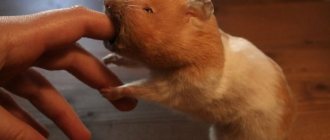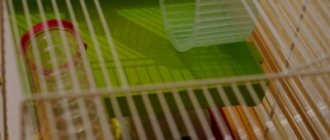Hamsters are very neat animals that independently monitor the cleanliness of their own bodies. Only for hygiene procedures they use sand, not water. With its help, rodents clean their coats and paws of dirt and excess fat.
Let's learn how to choose the right sand for your hamster and how to organize a bath for your pet yourself.
Brands and types of sand for bathing
ATTENTION: Do not use the first sand you come across. It makes more sense to first get acquainted with the opinions of experts.
Normal from the sandbox
It is advisable to take ordinary river sand not from a sandbox, where its origin is unknown, but to bring it from the river. Before use, such sand must be washed, dried, and calcined in a frying pan or oven for disinfection. But in extreme cases, you can also use construction sand. It must be sifted, rinsed thoroughly with running water, calcined, and then sifted again.
Sand for parrots
Cleaning the feathers of a bird and cleaning the delicate, thick fur of a hamster are very different things. Sand intended for parrots contains various additives and impurities - crushed shells as a mineral supplement, activated carbon, etc. It is not suitable for hamsters .
Sand for chinchillas
Sand intended for chinchillas is generally suitable for hamsters. The sand should consist of quartz and sepiolite (meerschaum), not contain talc additives, and have round-shaped grains.
Volcanic sand
Volcanic sand is not really sand at all. This is a finely dispersed substance, a mixture of zeolite and aluminosilicates, its composition differs little from ordinary clay. Volcanic sand not only does not bring any benefit, but is simply harmful . When bathing, animals usually try to bury their heads, and as a result, they fill their eyes and ears with dust, and also inhale it. This can lead to severe respiratory problems.
Popular brands of sand for bathing a hamster
- Chinchilla sandy. Vitakraft, Germany. Expensive. Cleans fur perfectly and gives it shine. Packaging – 1 kg.
- Beaphar XtraVital Bathing Sand. Netherlands. Eliminates grease, moisture, ensures cleanliness and shine of the coat. Guaranteed to be dust free. Packaging – 1.3 kg.
- Padovan bathing send. Italy. Expensive. Guaranteed to be dust free. Packaged in 2 liter plastic packaging.
- Little one. Germany. Heat treatment guaranteed. Packaging – 1 kg.
- JR Farm. Bavaria. The grains of sand have a round shape, without sharp edges.
- Animals. “Zoomir”, Russia.
- Waka Neat. Russia. Mentioned because of the low price.
How to make a bathing suit for a chinchilla with your own hands
You can easily make a container for bathing your pet with your own hands. For this you can use either plastic, plywood or wood. The simplest, fastest and easiest option is to make a plastic bath, which is installed in the rodent’s house during bathing.
Important. When washing plastic containers, it is recommended to use only clean, warm water, avoiding the use of strong chemicals.
Tools and materials
- clean plastic bottle 5-10 liters;
- a sharp knife that can cut through plastic;
- sandpaper.
Manufacturing process
- Place the plastic bottle on its side, having previously covered the surface with a cloth. This is done to prevent the bottle from slipping;
- cut an even hole on the side of the bottle, making it slightly larger than the size of a chinchilla;
- process the cut with sandpaper, cleaning the edges.
Before use, the finished bathing suit with an open entrance through the ceiling should be rinsed once under running water, washing away any remaining plastic sawdust.
Choosing sand for hamsters
Bathing sand, which is sold in pet stores, must have the following properties:
- purity and uniformity of structure;
- average grain size;
- non-toxic;
- cleaning properties, ability to adsorb fat;
- ability to absorb moisture and unpleasant odors well;
- natural bactericidal properties, preventing the development of bacteria and fungi;
- environmental friendliness;
- hypoallergenic;
- should not create dust.
How to get rid of dirt without water?
As noted above, the reason for bathing a dwarf must be serious. And in many cases, you can clean your pet without taking a “bath”:
- If you notice an unpleasant odor from the hamster’s habitat, then you should bathe the cage, not the hamster. Just change the bedding, thoroughly wash the accessories, clean the toilet area daily - and the unpleasant odor will disappear.
- If the dzhungarika seems dirty and greasy at six, or there are pieces of food or feces stuck to it, then there is no need to take water procedures. Sand baths will help cope with such contaminants.
- If candy, chewing gum or glue is tangled in a dzhungarik's fur, then it is enough to cut off the affected area of fur.
- If a rodent gets dirty with food and cannot deal with the contamination on its own, you can wipe its fur with a damp cloth or cotton swab.
Related article: How to transport a turtle on a plane, train or car
If skin diseases are present, many experienced rodent veterinarians will prescribe medications that do not require washing your pet. For example, sprays and injections.
Purchase of sand
The price of different brands of sand can vary significantly. Not only quality plays a significant role, but also the manufacturer’s brand. You should carefully study the composition of the filler, and everything else that is usually indicated in small print.
You should not make large reserves of filler unless absolutely necessary.
REFERENCE: A pack of filler weighing 1 kg for Djungarian hamsters normally lasts for about six months, for Syrian hamsters – for 3-4 months.
What can I use instead of bathing mixture for chinchillas?
An alternative to purchased sand can be homemade sand for bathing chinchillas. Volcanic or coral sand is ideal for these purposes, but they are extremely difficult to find. You can use river water, but only the smallest fraction. You should not take regular construction sand along roads or from playgrounds.
Sand for bathing chinchillas
Before use, sand must be prepared:
- remove all debris from it and rinse thoroughly;
- bake in the oven and let cool;
- add a few teaspoons of medical sulfur to prevent parasites and talc - improves moisture absorption, makes the sand more crumbly.
This bathing mixture is a significant financial savings for those who have many individuals living with them. If there is only one animal, it is more advisable to use purchased options.
Bath for hamsters
The animal will not see much difference between a purchased bath and a home-made one, since the hamster, as a sensible animal, is not interested in the form, but exclusively in its content.
Brands of bathtubs
- Super Pet. Ceramic bath for dzhungarika. The bath is compact and durable. Since ceramics are too tough for a hamster, they will last a long time.
- Savic wellness batc. The bathtub is intended, judging by its size, for Syrian hamsters. Material: non-toxic plastic. Equipped with a removable top.
- Plastic bath. Suitable also as a permanent toilet. It has a length of 17 cm, that is, it is suitable for both Dzungarians and young Syrians.
- Super pet chinchilla bath house. A bathing house with an original design, reflected in the price.
Baths for sand bathing from improvised means
Perfect for:
- old soap dish - for Djungarian hamsters;
- deep ceramic bowl;
- food container;
- plastic jar;
- a sufficiently strong cardboard box, etc.
With some effort, you can select a suitable container with a lid, cut a hole in the side, and adapt a ladder. The bathtub should be approximately twice the size of the animal and of sufficient height .
Bathing suits for chinchillas: basic rules for choosing
Modern bathing suits for chinchillas can have different shapes, sizes and materials: the assortment of pet stores usually offers a huge number of different devices for washing this animal.
When choosing this item, the owner should first of all pay attention to the size of the bathing suit, as well as its safety: all edges and cuts of the container should be well processed and not have any sharp protrusions that could injure the animal.
Important. It is optimal to choose bathtub models with high edges so that the filler does not spill out. At the same time, the edges should not be too high: the pet needs to be provided with an easy and accessible entrance to the bathing suit.
Swimwear sizes
Any container intended for washing a rodent in this way must meet certain requirements. So, the volume of this item must be at least five liters, and the size must be sufficient for the pet to fit completely in the bath and be able to freely carry out the cleansing process.
The larger the size of such a container, the more comfortable the pet will be, and the less sand will spill out, making the cleaning process easier for the owner.
The average size of this product is about 35-45 cm in length, 15-20 cm in height and 30 cm in width. Smaller baths may restrict the animal's movements during washing.
Tips for choosing baths for chinchillas
You should choose such a thing very carefully, focusing not only on the size, but also on the model of the product itself: the swimsuit should be quite stable and durable, easy to wash and not have sharp protrusions or corners.
The entrance to the bathing container must be no smaller than the size of the animal, otherwise the pet may get stuck at the entrance or exit. At the same time, the entrance hole must be inspected especially carefully, making sure that the sides are well processed and completely safe. Models with rounded blunt sides are very good.
Reference. A bathing suit can be a separate full-fledged container in the form of a box, aquarium or container, where the animal is moved while performing hygiene procedures. In other cases, the bath is a small house that is placed directly in the animal’s home.
We consider ceramic to be the best option.
Bathing a hamster in a sand bath
A natural bath for hamsters is sand. There is no need to specially “wash” them. A sand bath should be done 1-2 times a week. The hamster is very happy with the sand, quickly climbs into it and flounders with pleasure. After half an hour, the bath should be removed. Using a brush, remove any remaining sand from the wool.
Pros of sand baths:
- Maintaining hygiene.
- Entertainment and exercise.
- Grooming, removing naturally dead epidermis.
The disadvantages of sand baths appear if the bath is left for a long time. This:
- Overdrying of the skin.
- The hamster will turn the bathtub into a toilet and wallow in dirty sand.
Pros and cons of sand baths
Advantages
Sand for Djungarian hamsters is not only a hygienic procedure, but also physical activity and entertainment. And for the Syrian hamster, sand can replace real bathing. Long-haired (Angora) hamsters are washed more often than others to maintain their beauty, but washing is a lot of stress for them. Sand allows you to achieve softness and shine, keep the fur clean, removing dead skin flakes and fallen hairs.
Harm
Possible if bathing recommendations are not followed. If the bathing suit is constantly left in the cage, or baths are abused, the skin dries out and loses its protective properties. The hamster will relieve itself in the sand and then roll around in it. The mixture of feces and sand will stick to the fur rather than clean it.
Is it possible to bathe a hamster in water?
It is strictly forbidden to wash your hamster in water (except in exceptional cases)! Swimming in water does not cause anything but panic and discomfort in hamsters.
Why you shouldn't bathe hamsters in water
Bathing in water is unacceptable for rodents, since evolutionarily they are not at all adapted to this procedure. A hamster, while “washing itself,” is already able to remove most of the dirt on its own.
Have you ever bathed your hamster in water?
Severe stress
Hamsters perceive water as something frightening and become stressed. When stressed, they behave restlessly, or, conversely, apathetically. The hamster dies from very severe stress. Stressed females may eat the young. It is necessary to remove the hamster, place it in a dark, secluded place, and allow it to calm down.
Hypothermia
Hypothermia leads to a cold. Place the hamster in a warm place, give a mixture of water and warm milk with honey. Give Enroxil drops (2 drops in the morning and evening for 10 days), immunomodulating drops Gamavit (2-3 drops). You can soak the pieces of bread with chamomile infusion. The hamster will disinfect its cheek pouches and oral cavity with them.
IMPORTANT! Medicines intended for humans should not be given to hamsters! Only a veterinarian can prescribe medications!
Violation of the protective layer of the skin
Water with shampoo washes away the protective fat layer from the skin. This disrupts the acid-base balance and leads to dermatitis, swelling, and itching. The animal is itching. Neglected cases lead to ulcers.
Injuries
Hamsters panic when bathing - they bite, break out, and can fall to the floor and injure themselves. The injured hamster is limited in its mobility (placed in a carrier) and kept there until recovery. If there is an open fracture, contact a veterinarian.
How to tell if your hamster is sick after bathing
The hamster sneezes, has a runny nose, discharge from the eyes, tousled fur, lethargy, and dirty genitals. The hamster closes its eyes, loses weight, refuses food, and does not drink.
How to accustom to a drinking bowl
Algorithm of actions when familiarizing a hamster with a drinking bowl:
Place a block of water. Watch the animal. When an unfamiliar object appears in the cage, the animal will definitely study it. During the familiarization process, rodents most often independently figure out what exactly the device is for.
If the pet has not shown interest in the water bowl, which is very rare, you need to pick it up and carefully bring it to the water supply tube. As soon as the animal notices a drop of liquid, it will immediately understand why a new object is needed in the cage.
You can directly apply some water to the rodent’s nose with your finger.
Learn how to make your own hamster toys.
How to properly bathe a hamster?
- Water is slightly above room temperature.
- ONLY special zoo shampoos are used.
- Excessive foam is not allowed.
- Water and foam are not allowed to get on the muzzle.
- After soaping, the foam is immediately washed off.
- After bathing the hamster, dry it COMPLETELY, and only then release it from your hands.
How to wash Djungarian hamsters?
Djungarian hamsters tolerate water better. However, this procedure is stressful for them too.
In order not to cause unnecessary trouble, it is better to replace the bath by wiping with damp cotton pads or a baby wipe (without fragrances). After this, the hamster should be dried with a towel or a light hair dryer.
How to wash Syrian hamsters?
Syrian hamsters, especially long-haired ones, are washed under a gentle stream of water, quickly, and only if absolutely necessary. You can wipe them with damp wipes. It's good to give them a sedative first. Dry with a towel or hairdryer.
The best material for swimwear
When choosing this item, the material from which the item is made is of great importance: the material must be non-toxic, durable and safe for the animal. Each material has a number of positive and negative features that are important for the rodent owner to consider.
Important. Sometimes you can find ready-made metal baths on sale, but they are considered the most impractical and inconvenient: such material is difficult to clean and scratches easily.
Glass
The glass product most often represents a separate container in which the animal is placed. This option allows you to observe the bathing process and easily remove your pet after completing the hygiene procedure.
Advantages:
- aesthetic appearance;
- glass is easy to clean and dries quickly;
- absence of sharp protrusions;
- does not absorb odors.
Flaws:
- sand can scratch the glass surface from the inside;
- an open top through which the animal can pour out the filler during washing.
Glass bathing suit looks aesthetically beautiful
Plastic
You can buy plastic baths at a pet store, make them yourself, or use existing household items as a rodent bath, for example, a small food storage container or a picnic container.
Advantages:
- availability;
- strength and durability;
- practicality - usually plastic bathing suits have a closed lid and a spacious entrance;
- ease of care for a platinum bathtub.
Flaws:
- A plastic container, as a rule, is quite light in weight, so the animal can turn it over.
Wooden
Wood is a natural material that a chinchilla will love: the pet can gnaw lightly on wooden baths, grinding down its teeth. In addition, the wooden product looks very original and presentable.
Pros:
- spectacular appearance;
- completely natural material;
- variety of models.
Minuses:
- fragility - wood can easily become unusable, especially when a pet tries to sharpen its teeth on such material;
- It is quite difficult to wash such a bathing suit;
- absorbs odors.
Ceramic
Many chinchilla owners prefer ceramic baths because of their practicality, beauty and safety. This item is easy to install in your pet’s house and easy to clean after bathing.
Pros:
- stability - ceramic bathing suits are quite heavy, so the animal will not turn them over;
- practicality - such a thing is easy to wash and dry;
- does not absorb odors;
- durability.
Minuses:
- sometimes there are models with an entrance that is too high, where it will be difficult for the pet to climb;
- the cost of such products can be quite high.
From plywood
Plywood options are good for their environmental friendliness and naturalness. In addition, you can easily make a plywood bath with your own hands.
Advantages:
- environmental friendliness;
- availability;
- original appearance.
Flaws:
- fragility;
- difficulty in cleaning the product;
- plywood can absorb unpleasant odors, which are very difficult to remove.
Reference . The best option for a pet chinchilla is a ceramic container, while the most affordable is a plastic or plywood container.
You can make a bathing suit with your own hands
Rules for caring for hamsters
If you want to have a living creature at home that is interesting to watch and does not require special care and walking, then a hamster fits this category perfectly.
The only troublesome point is that all hamsters are active at night, so at this time of day they will fuss, puff and even squeak
They don’t need your attention at this time, so you can simply move the cage to another room
Choosing a house
You should not place your new pet in a bottle or aquarium - such dwellings are poorly ventilated and quickly “suffocate”. Moreover, due to stale air, your little friend may get sick.
Whether it's better to buy a cage—with or without bells and whistles—depends on your financial situation. The hamster will feel comfortable in a warm, clean and dry home, and all the play equipment is an optional nice addition.
If you are getting a mixed-sex couple, then you need to buy a cage of such a size that each pet has personal space.
A hamster is a burrowing animal, so paper (not newspaper, as printing ink releases a toxin that is dangerous for a small animal) or sawdust is suitable as bedding. You can buy special litter for rodents in pet stores - it absorbs moisture well and prevents the spread of odor.
Nutrition
The hamster will try everything you offer him, but it is best to feed him a special mixture that contains all the nutrients and vitamins the animal needs. Periodically, 2-3 times a week, you can pamper your pet with fresh vegetables and fruits. Try to use ripe hard fruits for treats - cucumber, apple, pumpkin. You can give greens.
A hamster can eat anything, so it is important to carefully monitor its diet. Sweet soft fruits will stain the cage and animal and may also cause diarrhea
Sweets, chocolate, baked goods are strictly contraindicated for rodents
Sweet, soft fruits will stain the cage and animal, and can also cause diarrhea. Sweets, chocolate, baked goods are strictly contraindicated for rodents.
Don't forget to drink! There should always be a drinking bowl filled with fresh water in the house.
Conclusion: the hamster is clean, unpretentious in food, and does not require special care. You can bathe your hamster, but you don't need to.











